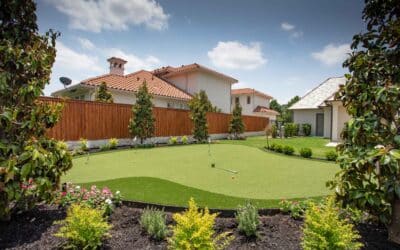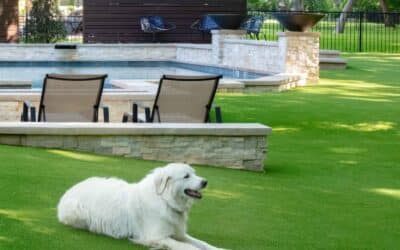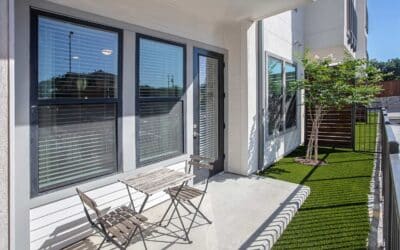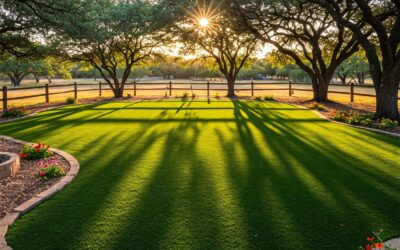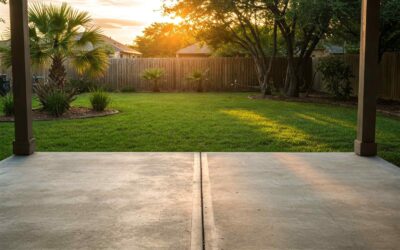Read time: 10 minutes
The difference between artificial grass that looks fantastic and lasts 15 or 20 years and grass that lasts 5-10 years is not just the quality of the grass itself. It’s what happens underneath the grass.
During the installation of a backyard lawn, pet turf, putting green, kids’ playground or another synthetic turf area, a lot goes on under the visible artificial grass surface. You don’t just roll out a length of turf and pray for good weather!
There is a science behind installing the turf’s base layer, which is where the skills and experience of your installation team come to the fore. A professional team will assess your project spaces and advise what to put under artificial grass to maintain peak performance in the years ahead.
What factors affect how artificial grass is installed?
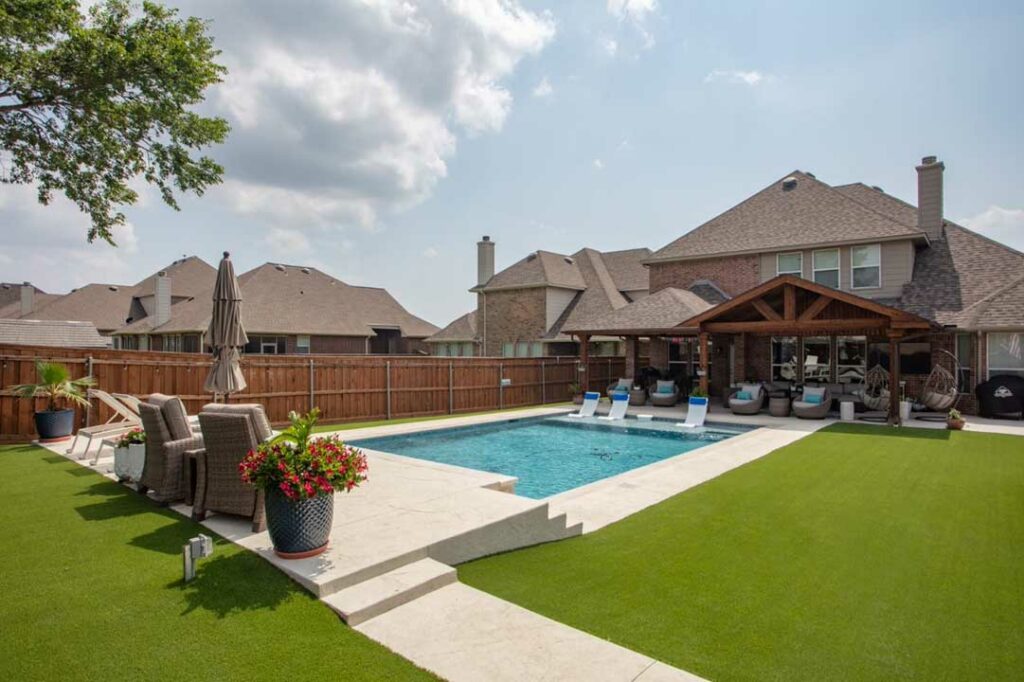
Before installing artificial grass, the following factors must be considered:
- The existing area: whether you’re replacing existing natural grass or installing your grass over another type of ground cover, the area needs to be flat and even with good drainage before installation can begin.
- The climate: in a sub-tropical climate like Austin, TX, artificial grass must withstand intense heat as well as storms. This creates some challenges in terms of drainage and the ability of the turf to withstand strong direct sunlight.
- The intended usage of the turf: if you’re installing a backyard putting green, it has different preparation requirements to swimming pool turf or a front yard lawn.
- Traffic level: the level of foot (and paw) traffic will affect the wear and tear of the artificial grass and may necessitate some different preparation; if you want to be able to drive on the grass, that creates further complications.
- Pets: if your dog or cat will be using the intended grass area, some extra thought must go into how to deal with odors that can arise from dog pee or poop.
- Slopes or hills: sloped synthetic grass area needs some extra preparation compared to flat areas to avoid slippage.
Regardless of your proposed installation area, good preparation of the ground is always necessary before artificial grass is installed.
Why do we need to prepare the ground for artificial turf?
A poorly prepared base layer will cause similar problems to a poorly prepared area under a newly laid carpet — only worse because most grass areas are outside and exposed to the elements.
Bumps or wrinkles may form, spots may sink into the ground below and the edges of the grass may start to lift. Uneven surfaces can cause accidents, weed infestation becomes more likely and the area may also be more susceptible to pests if it’s not properly installed on a solid, compacted sub-base.
The backing of your artificial turf will have multiple drainage holes to let water (or dog urine) freely pass to the base. But the water needs to go somewhere: to a drain or other waterway — or your grass area could develop puddles (attracting mold, bacteria and other unwanted visitors).
Drainage must be carefully planned before your artificial grass installation. As a general rule, “flat” areas should have a minimum slope of one-quarter of an inch per foot, which should channel water to a runoff point and prevent turf degradation:

There can be no shortcuts here. The layers under artificial grass will be a major factor in how long it lasts.
Make sure you choose a dependable and established turf installation company. The sub-base layer is invisible so it may be too late to do anything about the installation once a contractor has laid the artificial grass on top. You’ll probably only notice a few months (or even years) down the track.
Many artificial grass manufacturers provide recommendations when installing the artificial turf base layer and if these are not followed, you may lose your warranty protection.
At Artificial Grass Pros, we provide a 15-year limited warranty on all work so you can install your grass with complete peace of mind.
What usually goes under artificial grass in Austin?
Usually, artificial grass replaces natural grass in the Austin area. Homeowners are after the benefits of a low-maintenance, water-conserving option.
But this requires some preparatory steps…
At least a couple of weeks before the planned installation, shut down the sprinkler system and stop watering the lawn. A strong, non-toxic weedkiller should also be applied to the surface to attack the grass seeds. This will accelerate the decline of the natural grass.

If you have longer (up to a few months), you can solarize the area, i.e., cover it with black plastic and let the sun bake the entire area to death.
Artificial grass can then be laid — but not before you prepare a sturdy layer of sub-base material, which will aid drainage and hold the nails used to secure the grass.
Remove the existing ground cover
Before the base layer is added, around four inches of grass and soil must be removed from the surface. A sod cutter will make a smooth surface that is ready for the new base layer.
We will also check that there are no water pipes, electric lines or other underground hazards lurking under the surface of the planned installation area. Existing sprinklers should be covered at the pipe level or removed if they’re not needed.
Once the soil and grass are removed, pressure must be applied to compact the remaining soil layer, usually by walking over it. The installation area can be delineated using bender boards.
Note that although you want to remove weeds and roots, a weed barrier cloth under the sub-base layer is not appropriate for pet turf as it will trap bacteria (more about pet turf later).
If you’re installing a backyard or front yard lawn and don’t have pets, you could consider a weed barrier under the base layer and another one just above it before the artificial turf is laid.
Artificial turf base layer
It’s finally time to install the base layer.
The most effective base for artificial turf according to most manufacturers is a class II road base. This is made out of sand, gravel and crushed stone and is usually treated with lime to improve compaction.
You’ll see this type of base material in parking lots and driveways. It should function a little like native soil in terms of the drainage system it provides — but without the unwanted organic matter.

Around two or three inches of the base layer should be added and dispersed evenly throughout the area. For artificial grass, the sub-base should not contain too much sand as it can cause post-installation slumping.
The entire area should be watered well with a garden hose, taking care not to wash any of the sub-base rocks away. It can then be compacted using a stamp compactor, plate compactor or plate tamper. Extra special care must be taken at concrete edges and around trees and other landscaping features.
Climatic considerations in Austin
The Austin area is known for its long summer heat and humidity. While artificial grass in any area needs a well-compacted sub-base with a stabilizer, it’s even more important in our climate.
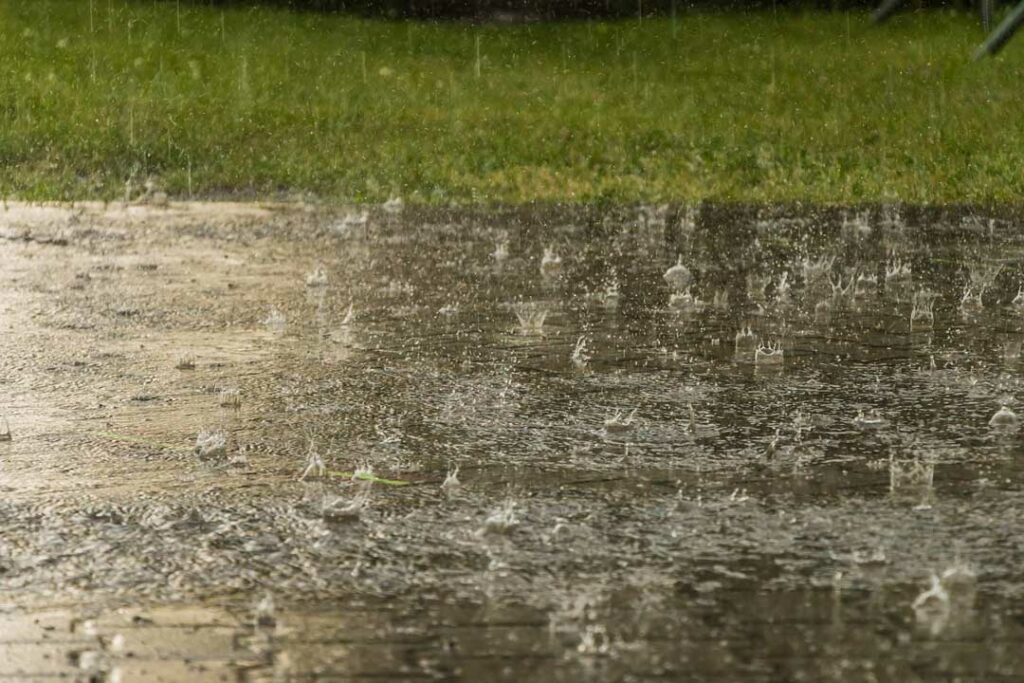
To ensure that your base won’t wash away with rainfall, you need a stabilizer added after the sub-base has been laid and compacted.
If the area does not enjoy naturally good drainage, your installation team may need to add drainage pipes to channel the water away. This is in addition to using an artificial grass type that drains extra well.
What goes under artificial grass on concrete?

A poorly draining artificial grass area will lead to mold and mildew forming. With a professionally installed sub-base layer, this is not a problem but concrete often actively prevents good drainage.
Artificial grass cannot be nailed in place on a concrete base either. So, an adhesive will be required to ensure that the grass doesn’t slip or form ugly wrinkles.
For the installation of artificial grass on concrete, any sharp edges should be removed to make the area smooth, ease the gluing process and prevent rips or tears. The concrete surface must also be washed thoroughly with a hose. If puddles form on the surface of the concrete, drainage holes should be drilled and filled in with shingle.
Other than drainage, the other problem with installing artificial grass on concrete is if anyone slips and falls. It can cause serious injury unless you cover the concreted area with foam or shock pads before laying the grass. Sections of shock pads should be taped together and glued to the concrete.
What to put under artificial grass for dogs
Pet turf installations are similar to standard lawn installations over existing grass or soil but there are a few extra considerations if you have dogs.
If you want a pet-friendly lawn or dog run area, we prepare the sub-base in the same way as described above — but with one big difference.
Adding a deodorizer layer alongside the compacted sub-base layer before rolling out your grass will help avoid those nasty ammonia smells from dog urine. You’ll still need to hose down your grass from time to time and collect any poop but the deodorizer should ensure that your family can use the lawn too.
At Artificial Grass Pros, our pet turf has antimicrobial properties, which also helps to prevent odors.
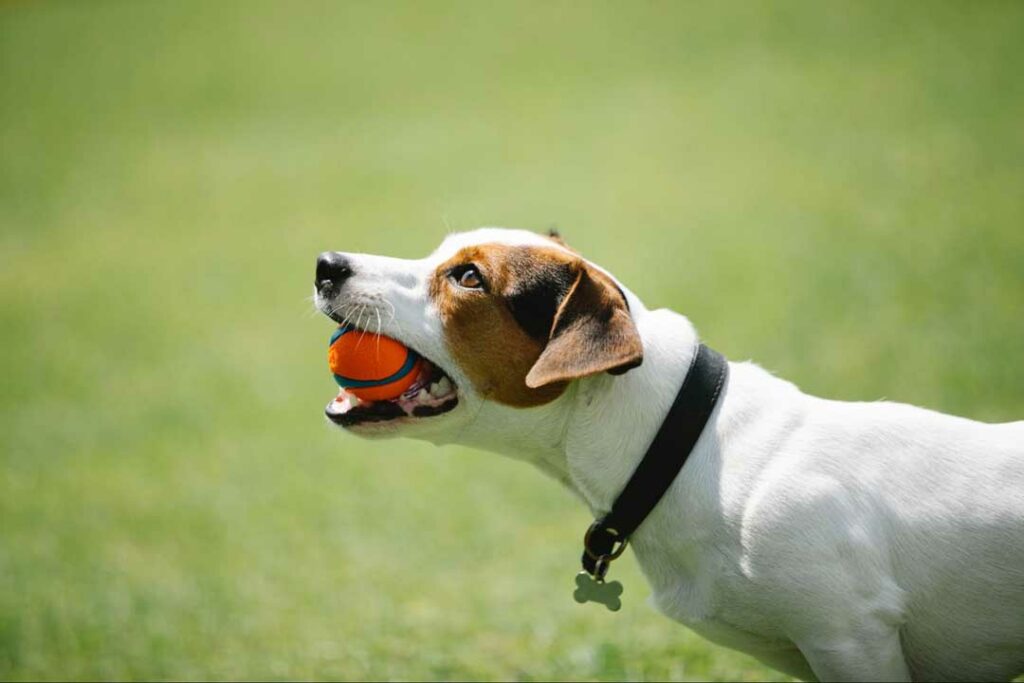
Do not use a weed barrier when installing pet turf as this can trap bacteria and cause odors. Non-toxic weedkillers will need to be used to prevent unwanted weeds from popping through your artificial turf. We’ll also ensure that the area drains so that pet urine drains well away from your grass.
What to put under artificial grass on slopes
Slopes provide extra challenges for artificial grass installations as the turf needs to be secured to prevent natural slippage over time.
For slopes under 15 degrees, it’s usually best to lay wire mesh (chicken wire will do) before adding the base and compacting it. This will help bind the sub-base and prevent the grass from slipping after being secured in place.
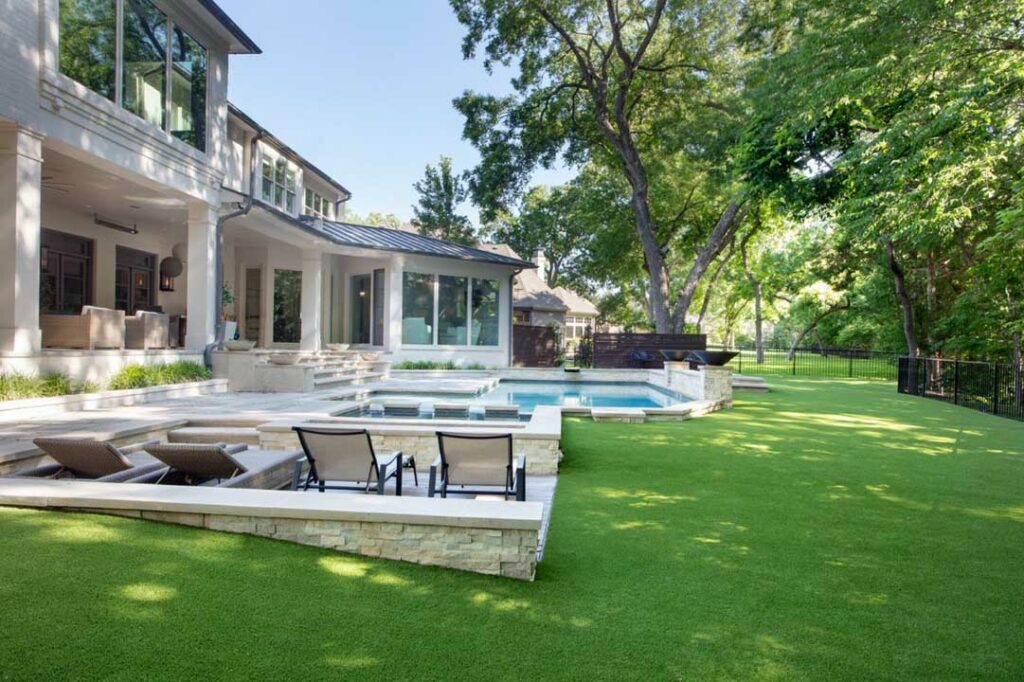
For steeper slopes, a stabilization membrane cell will be required. This is again placed on the surface before the base is added and compacted. The area should be smoothed down using a half-inch layer of decomposed granite and then the area compacted again.
What to put under artificial putting greens
Backyard putting greens are popular additions to yards in Texas — but what goes under an artificial grass putting green?
Again, most of the process is the same as for standard lawn installations but there are some extra considerations for putting greens: particularly flatness, the roll of the ball and (with chipping areas) how the ball lands.

If you want a green that closely resembles the greens at your local golf club, special attention must be paid to grading and leveling. When the putting green turf is laid, any bumps, dips or uneven areas will be accentuated because of the short pile height of putting green grass.
A thin layer of decomposed granite on top of the compacted road base can help create a completely smooth surface.
If you plan on having a chipping area, so that you can chip golf balls onto your green (maybe over a bunker), you’ll also need to replicate how a golf ball lands on real grass. This may entail “shot pads” being installed under your putting green grass.
What goes under heavy-traffic synthetic turf areas?
Most of the preparations for artificial grass covered in this article are for areas of light to moderate foot traffic. But what if you have a particularly heavy-traffic area or want to install artificial turf that vehicles can be driven on?

In these scenarios, the base layer will need extra stability. Often, for such heavy-use grass, geotextile permeable paver tiles are used to provide the additional support and stability necessary.
These paver tiles are laid over the sub-base, which is prepared and compacted as described above. Then the artificial turf can be rolled out on top.
FAQs
Will decking rot under artificial grass?
Artificial grass can be laid on decking or balcony areas if installed correctly. It must be secured in place effectively and drainage considerations adequately accounted for. Without good drainage, exposure to the elements could cause the area to attract mold or mildew.
How long does artificial grass last?
With high-quality grass, the right installation team and good maintenance, artificial grass can last 10-15 years or more. If your grass is installed with a poor base layer, this will likely reduce the life of your grass.
Can I install artificial grass myself?
Most homeowners do not have the necessary experience or tools/machinery to adequately prepare the ground and the base layer before installing the grass on top. Without a sturdy, compacted and stable sub-base, your artificial grass can run into multiple problems.
To adequately follow manufacturers’ recommendations when installing the artificial turf base layer, it’s best left to professionals to protect the warranty.
Does the price quoted include everything?
The ultimate cost of artificial grass depends on multiple factors but the quote you get from your artificial grass company should cover the fully installed turf. This should be made clear in the quotation — if not, double-check what you’re getting for your money.
Professional artificial turf installations…
With a professional installation and the right choice of turf, artificial grass is a cost-effective, low-maintenance, drought-resistant option that should last for up to 10-20 years.
But what goes under the grass is key to its longevity. Synthetic grass works best on a flat, compacted, well-draining base layer installed by professionals.At Artificial Grass Pros, we can look after your project from start to finish. Reach out to our helpful team by calling 512.296.1500 and we’ll be happy to provide a quote.

